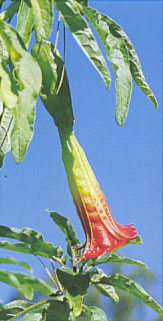
|
|
| Brugmansia sanguinea - Blood-Red Angel's Trumpet - Solanaceae - South America |
|
FAMILY: Solanaceae (Nightshade) Brugmansia Sanguinea is a perennial shrub-like tree, indigenous to the midlands of South America. It can grow 15 feet (5 meters ) tall, with long thin oval shaped leaves that grow up to 16 inches (40 cm) long and 6 inches (15 cm) wide. The flowers are up to 9 inches (23 cm) long, narrow and trumpet shaped, and range in color from a light pink to a deep blood-red, but it can also produce flowers that are pure yellow, yellow–red, green¬–red and pure red. Unlike the closely related Golden Angel’s Trumpet, the Sanguinea’s flowers do not produce an aromatic fragrance and tend to be slightly smaller. The plant’s stems, flowers, leaves and seed are known to contain large quantities of tropane alkaloids. Recent research has shown that the main active compound in this plant is Scopolamine, it also contains aposcopolamine, atropine, hyoscyamine, meteloidine, and norscopolamine. All of these compounds may be illegal in most parts of the world when extracted from their naturally occurring sources. TRADITIONAL USE: Mestizo Shamans have used the Bloodred Angel’s Trumpet as a sacrament in their burial ceremonies and grieving rituals. It was believed that widows would be gently lulled into the afterworld by consuming a hallucinogenic maize beer, Chicha, while they were being buried alive with their deceased husband. Chicha was made from corn, tobacco and the Sanguinea flowers and allowed to ferment. Modern day shaman’s use this traveling plant to communicate with their ancestors as well as the animal spirit world, diagnose disease, find lost objects, prophesize and to predict the future. The native tribes still use the seeds, mixing them in with coffee, to induce sexual arousal or to harm someone and put them into a coma or even kill them, depending on the dosage. TRADITIONAL PREPARATION: There are several traditional ways in which the seeds, flowers, and leaves were prepared to produce various intoxicating drinks, teas and powders. The native Canelo Indians would scrape the pith from the stem and flowers and squeeze out the juices, which were then consumed straight away. Other preparations include steeping the leaves and flowers in hot water to make delirium inducing teas; in some areas the seeds would be dried and powered and then added to Chica, a fermented maize beer; there are also reports of Indians mixing the dried leaves with tobacco and smoking the resulting blend. One of the most powerful decoctions was exclusively made and consumed by shaman, they boiled the fruits and seeds of the plant to produce a potent drink called tonga. MEDICINAL USES: It seems that almost every tribe in region had a different medicinal use for this magical plant, most prominently it was used to treat rheumatism and arthritis. It has also been used to treat sore throats, stomach pains caused by parasitic worms, to cleanse wounds of infected pus, and to help sooth irritated bowels and reduce flatulence. Due to many undesirable side effects and after effects there are no currently accepted medicinal uses for this plant. Although, today in Ecuador, the pharmaceutical industry grows Brugmansia to produce pure Scopolamine for medicinal purposes. TRADITIONAL EFFECTS: One of the earliest documented reports of the effects Brugmansia was written in 1846 by Johann Tschudi: the user “feel into a heavy stupor, his eyes vacantly fixed on the ground, his mouth convulsively closed, and his nostrils dilated. In the course of a quarter hour, his eyes began to roll, foam issued from his mouth, and his whole body was agitated by frightful convulsions. After these violent symptoms had passed, a profound sleep of several hours’ duration followed.” It is during this delirium that users reported hallucinations, visions, and communication with the animal spirits. This is certainly a very powerful Shamanic traveling plant and needs to be studied with great care. Unfortunately, ingesting it is a crime in most parts of the world, so any study can only be historical, rather than actually working directly with this plant or any preparations that may have been made from it. Erowid. 2009. Brugmansia. Erowid.com |
|
Related
Articles :
|
|
| Email
This Article To A Friend - Print
This Article Articles can be E-mailed to a friend and you can get a printable version of the article IMPORTANT: We provide all information for educational purposes only, and endorse or recommend nothing here. A special thanks to Keith for all his support and insight. |
|
